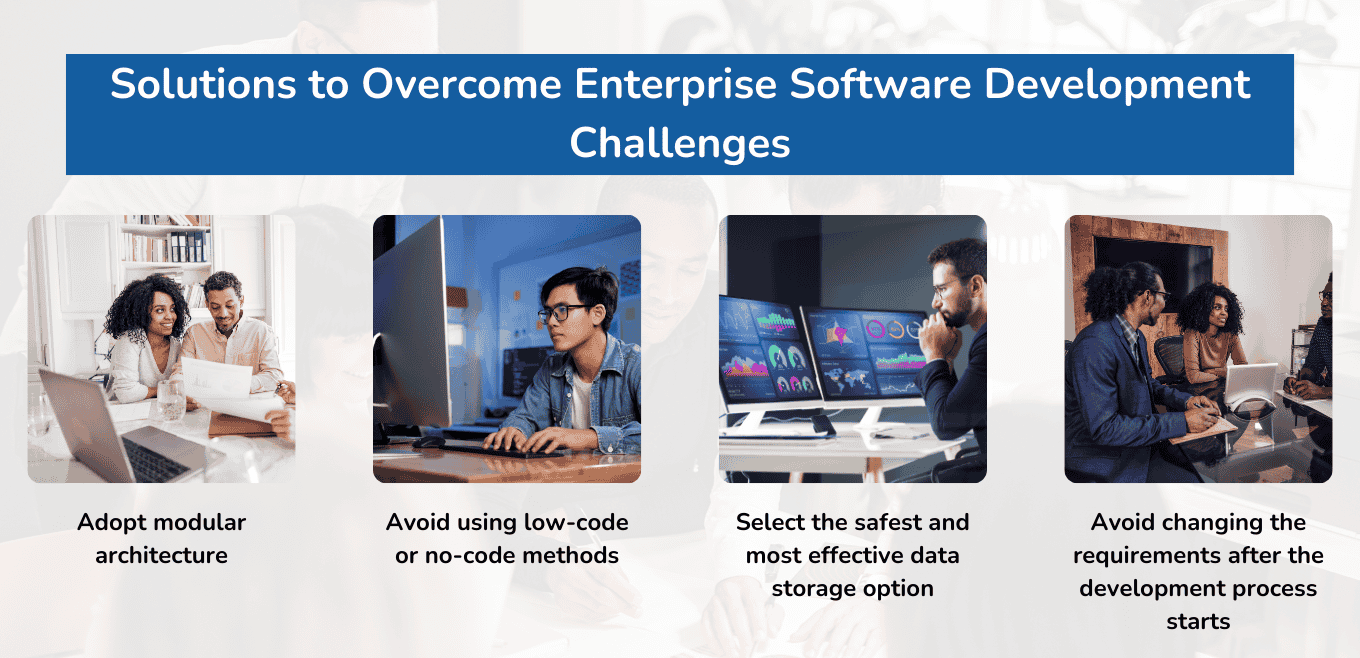With the increase in competition and shrinking economies, evolving tech trends can help the market thrive. Enterprise software development advances in line with the latest technologies and embraces new trends to meet complex business needs. During and after the pandemic, the enterprise software development domain has recorded significant growth. This is mainly because of the increasing demand for customized software across industry sectors. The global enterprise software development market is expected to expand at a CAGR of 11.5% in the next five years.
In addition to learning about current enterprise tech trends, businesses across all sectors must implement them consciously to gain considerable results. In this article, you’ll find a comprehensive list of trends that may be the best fit for your business and tech challenges you can encounter, along with their solutions.
What is Enterprise Application Development?
The process of creating, developing, and implementing software applications that are suited to an organization’s unique requirements is known as enterprise application development. Enterprise applications, as opposed to generic software solutions, are tailored to smoothly interact with databases, third-party apps, and current systems. Supporting corporate operations, increasing productivity, and strengthening decision-making procedures all depend on this integration. Enterprise software development ensures that the software is in line with the company’s objectives and processes by attending to specific business requirements. This, in turn, promotes operational excellence and corporate growth.
Top Challenges of Enterprise Software Development
Determining the best methods to guarantee the following attributes is the primary difficulty in creating enterprise apps.
1. Software scalability and flexibility
Although an enterprise is a large firm with a well-designed business plan and procedures, the pandemic demonstrated that owners should be equally prepared for expansion and reduction. Therefore, when new features or functionalities that streamline specific processes for your employees are seamlessly added to the app, your enterprise software needs to be prepared for the upgrade. Simultaneously, your enterprise software should enable you to disable or remove any modules and functionalities that are no longer needed without affecting the functionality of the remaining components. Business applications are essential for improving operational efficiency and employee engagement within organizations.
2. Changing business requirements
Your development team will most likely find this one to be the hardest. Determining what issues your corporate software should address both now and in the future is essential to the development process. Requirements that change frequently will probably have an impact on:
- deadlines;
- budget;
- motivation of team members to continue working on your project;
- overall efficiency.
You might believe that you’re making a small suggestion. Even a little change in requirements, however, results in substantial code modifications and extra testing when a sophisticated corporate program is halfway or nearly complete.
3. Enhanced security
Enterprise software frequently manages incredibly valuable and sensitive data, such as customer and corporate information, which needs to be safeguarded using cutting-edge technological methods. Typically, some particular rules and standards govern the implementation of security measures in enterprise software.
A flaw in one application could jeopardize the security of the entire company network. One of the main issues in developing enterprise applications is ensuring the highest security standards are met.
4. Storing data for ERP
In business software development, including for corporations, proper data storage and analysis of key business processes continue to be prevalent issues. Large volumes of data are generated, processed, and stored by enterprise software, making this a difficulty. This software must be able to store large amounts of data securely and quickly retrieve the data that is needed from the storage.
This is particularly difficult when most or all of the data is unstructured. Therefore, in the absence of a meticulously designed application architecture and infrastructure, your business software won’t be as efficient and fast-working as it should be.
5. Integrations with third-party APIs
Numerous businesses make use of monolithic, legacy systems that were created years or even decades ago. Improving monolithic legacy systems through intricate integrations with application programming interfaces (APIs) or third-party software solutions is extremely difficult. Enterprise resource planning (ERP) tools are essential to managing and integrating these essential business operations in real-time.
To determine the best enterprise app development or upgrade plan, you should first speak with a trustworthy CTO (Chief Technical Officer) if your enterprise business goals and needs cannot be met without integrating data processing, AI-enhanced, or other systems in your legacy. Regarding interactions with contemporary APIs and obsolete older systems, it’s quite probable that you will have to start with legacy application modernization and transform its architecture to microservice-based.
6. Hiring skilled and reliable technical experts
Finding tech experts quickly for your project is still difficult, even though the number of software development specialists worldwide is increasing annually and has reached 28 million. This is particularly true if you want to hire specialists for your internal team.
Not every tech expert available knows enterprise development and your sector. Therefore, it could take your hiring department weeks or even months to identify the people who are a perfect fit for your project. By automating HR tasks, improving employee engagement, and guaranteeing labor law compliance, human resource management solutions help expedite this process.
7. Integration with legacy systems
Legacy systems are outdated software applications that have been in use for a long time, often forming the backbone of an organization’s IT infrastructure. However, these systems can become a bottleneck when it comes to modernizing and streamlining business processes. Integrating legacy systems with new enterprise applications is a complex but essential task. Enterprise application development involves incorporating modern technologies such as cloud computing, artificial intelligence, and the Internet of Things (IoT) into these legacy systems. This integration enhances performance, scalability, and security, allowing businesses to leverage their existing investments while adopting new capabilities to stay competitive.
Create high-end software solutions for your company with People10
8. Business-IT communication gap
For corporate application development to be successful, business and IT teams must communicate effectively. On the other hand, poor communication can result in rework, delays, and wasteful resource utilization. These discrepancies frequently result from disparities in priorities, language, and comprehension of business needs. Organizations should use agile development approaches like Scrum or Kanban to close this gap. By encouraging cooperation, openness, and ongoing development, these approaches make sure that the IT and business teams are on the same page and pursuing the same objectives. Iterative feedback and open communication are two ways that firms can reduce risks and improve the effectiveness of their development process.
9. Adapting to Agile development
Agile development is an incremental, iterative method of developing software that prioritizes adaptability, teamwork, and quick turnaround. An organization’s culture must change significantly to adopt agile development. It entails embracing change, empowering teams, and dismantling organizational silos. Adopting agile approaches enables enterprise application development teams to decrease time-to-market, enhance software quality, and react swiftly to shifting business requirements. Regular stand-ups, sprint planning, and retrospectives are examples of agile techniques that assist teams in maintaining focus and continuously enhancing their workflows. Organizations may guarantee that their enterprise applications stay effective and relevant in a changing business environment by adopting agile development.
Strategies to Overcome Enterprise Challenges
Are there any particular approaches that are only appropriate for developing enterprise applications? Rather, there are a few universally recognized methods that have been shown to work well for software development of all kinds. Here are some tactical actions that can assist in resolving issues quickly and affordably.
- Specify the business and technical needs for your corporate software.
- Before starting the development process, seek advice from qualified and trustworthy software development specialists on a variety of important topics, including databases, software infrastructure, technologies, team composition, and many more.
- Examine and evaluate the software developed or utilized by other businesses, particularly those in your sector. Indeed, given that this program is primarily used internally by the organization, it might be challenging. However, you wouldn’t be doing your current duties at the enterprise company if you couldn’t complete challenging jobs.
- Make sure your target audience or employees can easily utilize your corporate app. Make sure an app is easy to use and straightforward. User interface and user experience are equally crucial. Someone from the development team will need to write a user manual or train employees on how to use the corporate app if its interface has to be complicated.
- Depending on the platform, pick the best tech stack.
- Keep a record of the development process and provide thorough documentation. It will undoubtedly be necessary in the future for software upgrades and for identifying bugs or weak points.
- Conduct thorough testing and gather input on your enterprise application.
Executing these steps carefully and consecutively will drastically decrease the number of potential obstacles during the development process.
Solutions to Overcome Enterprise Software Development Challenges

1. Adopt modular architecture
Enterprise apps will make it easier to integrate modules and systems into the application and help achieve improved scalability. Make sure that your application’s security features always take precedence over those of its integrated components. This reduces the likelihood that your software will be compromised by flaws in third-party solutions.
2. Avoid using low-code or no-code methods
They sacrifice security to save time and money. These methods have evident advantages and may be trendy. Even with a modest project budget, these software development methodologies will still have some disadvantages in terms of overall performance, scalability, and cybersecurity.
3. Select the safest and most effective data storage option
Businesses have the option of keeping data locally or in the cloud. Local data storage is more independent and safe. Although cloud storage is typically more convenient and less expensive, it is also more susceptible to data breaches. Additionally, it increases your company’s reliance on outside parties, such as Cloud service providers and Internet providers. Using both local storage and the cloud would be a smart approach.
4. Avoid changing the requirements after the development process starts
Since you are the project manager, you have the authority to make requests for modifications at any point during the product development process. Nonetheless, you should make every effort to specify the precise features and needs you have for your new company app. If not, every modification will cause the project’s budget to rise and its deadline to be extended. You might consider starting with creating an MVP version if you cannot provide a complete list of requirements at the outset.
When you seek advice and collaborate with experts, there is always a solution to even the most difficult problems with People10.
Conclusion
It could seem impossible to overcome every enterprise software development obstacle mentioned in this article. Building an application for your business will go well, though, if you know exactly what you want as a result, have a basic understanding of app development and software development procedures, have a reliable tech expert to consult, and can assemble a top-notch team.
Offering top-notch corporate software development services for a range of industries, People10 has over 13+ years of experience developing software for companies of all sizes, from startups to large corporations. Despite having a domain concentration on banking, insurance, healthcare, and aviation, we have successfully supplied and are still offering web and mobile solutions to numerous other industries.
We are eager to hear your needs if you’re searching for a trustworthy and knowledgeable enterprise application development partner. Discuss your company needs, and our staff will provide you with a customized and effective solution.
Unlock Your Enterprise's Potential with Tailored Software Solutions
Partner with People10 to overcome enterprise application development challenges and achieve your business goals efficiently.
Author
Shrutha Sekharaiah brings over 13 years of experience in delivering innovative, scalable solutions. His broad expertise in technology and focus on collaboration and mentorship drive the creation of robust systems enhancing efficiency and performance.



